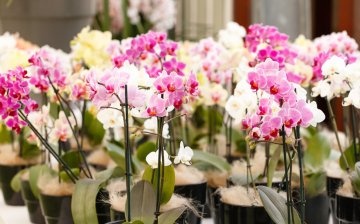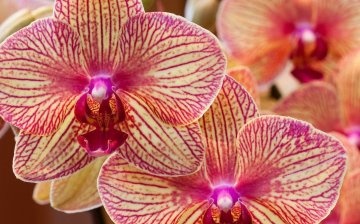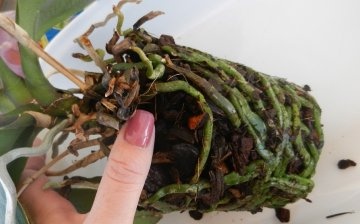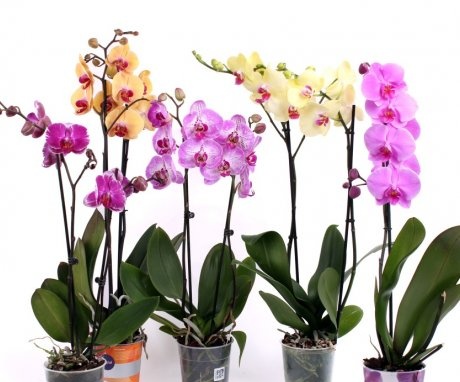Useful tips: do I need to transplant an orchid after purchase
Orchid belongs to the orchid family. This epiphytic plant in the wild, tropics, does not grow in the ground, but attaches to the bark of trees, can even grow on rocks. It feeds on deposits in the bark of the plant, receives moisture through multiple aerial roots.
Content:
- The best varieties of orchids for the home
- Reason for transplanting orchids after purchase
- Preparation of dishes and substrate
The best varieties of orchids for the home
In nature, there are about 30 thousand species of orchids. Only a few of them are grown indoors or in the garden:
- Phalaenopsis - the most widespread and popular type of orchid grown in culture. Does not require special care, blooms almost all year round. Differs in undemanding amount of light. Loves fresh air, but is afraid of drafts. From the moment the buds appear, the flower cannot be rearranged to another place, they do not change the conditions of detention.
- Wanda grows in nature at 100% humidity, using no substrate or support. Many varieties of the most varied colors have been created, including yellow, red, purple. Natural color is blue. Successful cultivation in indoor conditions is possible when air is supplied to the roots and a large amount of light.
- Cattleya is an orchid with large fragrant flowers of white, red, purple. Its petals are decorated with bright specks and spots. A very capricious plant that requires experience and constant attention. Grown on southern windows.
- Cymbidium is a tall orchid with long leaves and ovoid pseudobulbs. It does not bloom in indoor conditions. It is grown in the garden, planted in May, and taken indoors in mid-autumn. There are miniature forms. Flowers are cut for a long time.
- Dendrobium is grown in two types - Dendrobium Nobile and Dendrobium Phalaenopsis. The first grows up to 30 cm in height, does not like high temperatures. The flowers are white, yellow, purple. In the spring, the bulbs give off shoots that grow and prepare for flowering by autumn. Reduce the temperature in the room, less often watered. Phalaenopsis loves warmth more.
- Cambria combines flowers created from different types of orchids. The flowers are large, multi-colored, often interspersed. Grown in the north-east and east windows. Paphiopedilum (slipper) has flowers of the original shape. The lower petal is bent into a lip. Does not tolerate summer heat.
Reason for transplant after purchase
If the purchased flower does not hang out in the dish, has dense leaves, its roots are greenish, it does not need to be transplanted. Changing conditions of detention will be stressful for the plant. Wait until the roots begin to protrude from the top of the substrate.
Orchids most often sold in blooming state. An orchid, like most plants, is painful to transplant. She can throw off a peduncle or even die if transplanted incorrectly. But sometimes only a transplant can save a plant.
This happens when an orchid is purchased at a sale, and its condition is poor or critical. Sometimes the plant staggers in the pot. This happens if:
- Leaves develop on one side.
- The peduncle deviated strongly to the side.
- Little potting medium.
But sometimes, even in this case, you can do without a transplant.So that the dishes with the flower do not fall, they are placed in a heavy pot, a support for the peduncle is installed, or the substrate is poured.
Transplant an orchid if it is sick or weakened.
Examine the roots of the plant, which can be seen through the transparent walls of the pot. If they are brown or brown, this indicates rotting. Take the orchid out of the pot. Since it is plastic, it will not be difficult. Shake off the substrate, cut off rotten and damaged roots. Cut places are treated with crushed charcoal. Allow to dry for several hours. During this time, a new substrate is prepared, an orchid is transplanted into it.
If the roots are very weak, grow them in water. The roots are immersed in a third of the length. After 3 days, take out and keep dry for 24 hours. Alternate, gradually increasing the residence time in the water. When the roots grow back, the orchid is planted in the usual way or grown by the method hydroponics... Sometimes the plant is sold in poor quality substrate. Transplanted if it contains peat. This substance picks up a lot of moisture, which can lead to root rot. If the dishes are covered with sphagnum moss on top, it is removed. If the orchid is not transplanted at the same time, replace it with a substrate.
Preparation of dishes and substrate
The orchid pot is made of transparent plastic with drainage holes. Its dimensions are the same as before the transplant. Usually 12 cm in diameter is enough for a plant. For an adult orchid, this is 15 cm. If there is a lot of substrate in it, it will dry out for a long time. Leaves will grow, but the peduncle will not form.
The substrate for growing orchids has the following properties:
- Good air permeability.
- Doesn't get lost in a coma.
- Does not rot.
- Retains moisture.
Use a special substrate purchased from a flower shop, or prepare it yourself. Take pine bark, boil for an hour in water. This removes the resin and kills harmful organisms and insects. Cut into 2 cm pieces and dry.
Charcoal and crushed polystyrene are added to the resulting bark. If the air in the room is dry, add a quarter of the moss pot. In a room with high humidity, moss is not needed. For 5 parts of the bark, take one part of the other ingredients. Moss is ground before mixing.
More information can be found in the video:
Transplant process:
- At the bottom of the pot, a drainage layer of expanded clay or agroperlite is laid at a quarter of the height.
- The peduncle is removed before transplanting.
- Take the orchid out of the pot, clean the roots, rinse them with water at a temperature of 20 degrees.
- Dry for 15 minutes.
- Set the orchid in the dish.
- Fill up with a substrate so that large pieces fall down.
- The root collar and aerial roots remain on top.
Transplant care orchid consists in maintaining the level of humidity, light conditions, temperature:
- A layer of moss placed around the pot will help to increase the moisture content of the substrate.
- Do not plant the orchid in direct sunlight. Further placement depends on the type of orchid.
- Not installed in a draft, but the room is regularly ventilated.














Our phalaenopsis orchid grows in a plastic pot with several holes in the walls, instead of soil, it is filled with tree bark. The orchid has been growing under these conditions for several years and blooms every year.